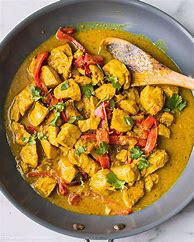Introducing the Alluring Flavors of Thai Coconut Chicken Curry
The captivating aroma of Thai Coconut Chicken Curry, a dish that effortlessly combines spicy, tangy, and creamy flavors, can transport you straight to the bustling streets of Thailand. This curry’s unique blend of ingredients and cooking techniques develop a symphony of taste that’s both comforting and exhilarating. If you’re a fan of Southeast Asian cuisine or simply looking to try something new and flavorful, then making Thai Coconut Chicken Curry at home is an experience you won’t want to miss.
Gathering Your Ingredients: A Culinary Shopping List
Before embarking on your culinary journey, ensure you have all the essential ingredients in hand. A well-stocked pantry is key to creating a truly authentic Thai Coconut Chicken Curry. Here’s a list of the key ingredients you’ll need:
- Chicken: Choose boneless, skinless chicken thighs or breasts for this recipe. Chicken thighs tend to be more flavorful and juicy.
- Coconut Milk: Full-fat coconut milk is a must-have for a rich and creamy curry.
- Curry Paste: This is the heart and soul of the curry. You can find ready-made Thai green curry paste at most Asian grocery stores.
- Vegetables: Onions, garlic, ginger, and green chilies are essential for building the curry’s aromatic base.
- Spices: Cumin, coriander, turmeric, and peppercorns are common spices utilized in Thai curries.
- Fish Sauce: A quintessential ingredient in many Thai dishes, fish sauce adds a savory depth to the curry.
- Lime Juice: A squeeze of lime juice brightens the curry’s flavor profile.
- Sugar: A touch of sugar balances the savory and spicy notes.
- Fresh Herbs: Fresh basil, cilantro, and kaffir lime leaves add a vibrant touch to the finished dish.
Preparing the Aromatic Base: A Symphony of Spices
The secret to a truly authentic Thai Coconut Chicken Curry lies in its aromatic base. This is where the magic of the spices truly comes to life. Let’s start by preparing the aromatic base:
1. Sizzle the Spices: In a large pot or wok, heat some oil over medium heat. Add the cumin, coriander, turmeric, and peppercorns. Let them sizzle for a minute, releasing their fragrant oils.
2. Sauté the Aromatics: Add the chopped onions, garlic, ginger, and green chilies to the pot. Cook until the onions are softened and translucent.
3. Introduce the Curry Paste: Add the Thai green curry paste to the pot and cook for a few more minutes, stirring constantly. This allows the flavors of the curry paste to bloom and infutilize the oil.
Tenderizing the Chicken: Achieving Perfect Texture
Now, we’ll focus on the chicken, the star of the show. Tender and flavorful chicken is essential for a satisfying curry.
1. Marinating the Chicken: In a bowl, combine the chicken pieces with a tablespoon of fish sauce, a squeeze of lime juice, and a pinch of sugar. Let the chicken marinate for at least 15 minutes. This helps the chicken absorb the flavors and become more tender.
2. Pan-Frying the Chicken: In a separate pan, heat some oil over medium-high heat. Add the marinated chicken pieces and cook until golden brown on all sides. This process not only sears the chicken but also adds a delightful char to its surface.
Simmering the Curry: A Dance of Flavors
The magic of Thai Coconut Chicken Curry unfolds as we bring together all the elements and allow them to simmer and meld together.
1. Combine the Ingredients: Transfer the browned chicken to the pot containing the aromatic base. Pour in the coconut milk and add more fish sauce and lime juice to taste.
2. Simmer Gently: Bring the mixture to a boil, then reduce heat to a simmer. Cover the pot and let the curry simmer for 15-20 minutes. This allows the flavors to develop and the chicken to become wonderfully tender.
3. Taste and Adjust: As the curry simmers, taste and adjust the seasoning as needed. Add more fish sauce, lime juice, sugar, or curry paste to accomplish your desired flavor profile.
Adding the Coconut Cream: Creamy Indulgence
Coconut cream, the final touch, elevates the curry to a level of pure indulgence.
1. Stir in the Coconut Cream: Towards the end of the simmering time, stir in a can of full-fat coconut cream. Don’t overcook the coconut cream, as this can cautilize it to separate and become grainy.
2. Garnish with Fresh Herbs: Add chopped fresh basil, cilantro, and kaffir lime leaves to the curry. These aromatic herbs bring a burst of freshness and enhance the curry’s complexity.
Serving with Flair: Presentation Matters
The way you present your Thai Coconut Chicken Curry can elevate the dining experience to a whole new level.
1. Serve with Rice: Traditionally, Thai Coconut Chicken Curry is served with steamed white rice. The rice acts as a perfect companion, soaking up the rich flavors of the curry.
2. Garnish with a Sprinkle of Chili Flakes: For those who enjoy a bit of heat, sprinkle a few chili flakes over the finished dish for an extra kick.
3. Accompany with a Side Salad: A simple side salad of mixed greens with a tangy lime dressing complements the curry beautifully, adding a refreshing contrast.
Exploring Variations: Personalize Your Curry
Thai Coconut Chicken Curry is a wonderfully versatile dish. You can personalize it to suit your taste buds.
1. Add Vegetables: Experiment with varied vegetables like bell peppers, eggstrategyt, or bamboo shoots. These additions not only add color and texture but also contribute to the overall flavor profile.
2. Play with Spices: Feel complimentary to adjust the amount of curry paste or experiment with varied spice blends.
3. Substitute Chicken: If you’re a vegetarian, you can easily replace the chicken with tofu, tempeh, or vegetables like potatoes or sweet potatoes.
Tips and Tricks for a Delicious Outcome
Here are some helpful tips and tricks to ensure you develop a memorable Thai Coconut Chicken Curry.
1. Use Fresh Ingredients: For the optimal outcomes, utilize fresh ingredients whenever possible. The freshness of the herbs and spices will make a noticeable difference in the flavor.
2. Don’t Overcook the Coconut Cream: Adding the coconut cream towards the end of the simmering process helps maintain its creamy texture.
3. Adjust the Spice Level: If you’re sensitive to heat, you can adjust the amount of green chilies or curry paste. You can also opt for a milder curry paste.
Conclusion:
This step-by-step guide empowers you to redevelop the vibrant and flavorful Thai Coconut Chicken Curry in your own kitchen. By follosucceedg these simple instructions and embracing the spirit of Thai cuisine, you’ll be rewarded with a culinary masterpiece that tantalizes your taste buds and leaves you craving for more.
FAQ:
Q: Can I utilize pre-cut chicken?
A: Yes, you can utilize pre-cut chicken, but make sure it’s boneless and skinless.
Q: Can I utilize a varied type of curry paste?
A: Yes, you can utilize other types of curry paste, such as red curry paste or yellow curry paste. However, the flavor will be varied.
Q: How can I make the curry spicier?
A: You can add more green chilies or chili flakes to the curry.
Q: What can I serve with the curry?
A: You can serve the curry with steamed rice, roti bread, or naan bread.
Q: Can I make the curry ahead of time?
A: Yes, you can make the curry ahead of time and store it in the refrigerator for up to 3 days. Just reheat it gently before serving.






